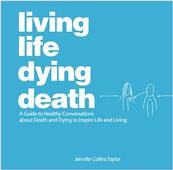 by Kate Christie Second Growth Books (2022) ISBN: 978-0985367794 Kate Christie is a technical writer who decided to write about her family’s experience with voluntarily stopping eating and drinking (VSED) so that others could know what to expect and how to handle it. Her book is slim, just seventy-two pages, but packed full with helpful information. It offers both timelines and tips. Her audience is those with a degenerative disease or other terminal condition that renders them unable to qualify for medical aid in dying, and individuals who are terminally ill and reside in a region where medical aid in dying isn’t available. VSED is authorized in every state and is an option for those who wish to hasten their death. It takes much longer to die than medical aid in dying, but is sometimes the only choice. Christie’s mother suffered from early Alzheimer’s and made clear to everyone that she didn’t want to die among strangers. “If you put me in a nursing home, I will come back and haunt you,” she said. She feared an agonizing cognitive decline in a care facility where she would likely be sedated and restrained while she “slowly forgot every experience she’d ever had.” To avoid this, she would have to “give up good days to avoid bad years.” She told her doctor this was her desire and she told her husband and children the same, over and over; she would stop eating and drinking. When she decided the time had come, they were emotionally prepared. They had a private home where it could happen, the financial resources to hire the helpers they would need, and friends who would help with meals for those who were maintaining a vigil at the bedside.
Christie’s message is that dying by VSED can be successfully done but requires careful advance planning. There will be the need for a hospital bed, bedside commode, and walker, and for palliative medications prescribed by a medical practitioner. It is important to ascertain who one’s allies are. If there is dysfunction in the family, it’s not going to magically disappear because we announce that we plan to die. There have been instances of unsupportive family members calling in eldercare services to stop what they saw as abuse. Seeing an attorney early on is imperative, to draw up release-of-liability forms for family members and paid caregivers. Making a video explaining the reasons for wanting to die will be helpful to those who need reassurance, and at the same time, making a second video addressed to ourselves will remind us of why we want to die when we ask for food or water after the process has begun. Accompanying someone through VSED requires being attentive every minute. During the early stage (1-4 days) the patient will be weak but fully present, able to enjoy conversations, listen to a playlist of favorite music, or perhaps simply enjoy a view from the window. The second stage, lasting various numbers of days, will include thirst, weakness, agitation and/or confusion and palliative medications will need to be provided. Managing medication levels properly can mean the difference between a peaceful death and a harrowing one. The last phase (1-4 days) will include agitation, delirium and unconsciousness, and the entire process may take as long as two weeks. Contrary to widely held belief, hospice visits are intermittent, so it will be important to have other bedside caregivers. Family members should be allowed to participate or not according to their comfort level. Often, they will want someone medically trained to administer the medications. They may want paid caregivers to help with bodily hygiene, while feeling comfortable themselves offering lip balm, oral foam swabs and atomizer spray. There are other things to think about. Addictions need to be recognized and dealt with before the process begins, to avoid withdrawal symptoms. Anti-anxiety medication should be tested. Calories should be reduced and one should consider a colon cleanse. The Christie family wondered if there might be a faster, more humane alternative to dying by VSED, such as a drug overdose, but they decided that taking a deliberate action to end life felt different from VSED, in which an individual fails to take an action (eating and drinking). If the overdose didn’t work and the suicide failed, that would only make matters worse. Medical aid in dying might have been the Christie family’s choice – she says as much – if the law had allowed it for someone suffering from dementia. In the absence of such a law, this is a helpful book for those who are caught in the bind. Review by Susan Gillotti, PCV Board Member
Emily Jones
3/15/2023 06:54:12 pm
Many thanks for all the work you do. Comments are closed.
|
Being Mortal
by Atul Gawande Medicine has triumphed in modern times, transforming birth, injury, and infectious disease from harrowing to manageable. But in the inevitable condition of aging and death, the goals of medicine seem too frequently to run counter to the interest of the human spirit. Nursing homes, preoccupied with safety, pin patients into railed beds and wheelchairs. Hospitals isolate the dying, checking for vital signs long after the goals of cure have become moot. Doctors, committed to extending life, continue to carry out devastating procedures that in the end extend suffering. Gawande, a practicing surgeon, addresses his profession's ultimate limitation, arguing that quality of life is the desired goal for patients and families. Gawande offers examples of freer, more socially fulfilling models for assisting the infirm and dependent elderly, and he explores the varieties of hospice care to demonstrate that a person's last weeks or months may be rich and dignified. Full of eye-opening research and riveting storytelling, Being Mortal asserts that medicine can comfort and enhance our experience even to the end, providing not only a good life but also a good end. To Die Well: Your Right to Comfort, Calm, and Choice in the Last Days of Life
by Sidney Wanzer, M.D. and Joseph Glenmullen, M.D. The information in To Die Well is both comforting and empowering. Knowing our rights to refuse treatment, as well as legal ways to bring about death if pain or distress cannot be alleviated, will spare us the frightening helplessness that can rob our last days of meaning and connection with others. Drs. Sidney Wanzer and Joseph Glenmullen do not shy away from controversy. They make clear what patients should expect of their doctors, including the right to sufficient pain medication even if it shortens life. They distinguish between normal sadness and depression. They also explain the ways to hasten death that are legal and possible for anyone, and those that require a doctor's help. A Good Death: Making the Most of Our Final Choices
by Sandra Martin A Good Death is timely, engaging and inspiring. In taking on our ultimate human right, award-winning journalist Sandra Martin charts the history of the right to die movement here and abroad through the personal stories of brave campaigners like Sue Rodriguez, Brittany Maynard and Gloria Taylor. Martin weighs the evidence from permissive jurisdictions such as the Netherlands, Oregon, California, Switzerland and Quebec and portrays her own intellectual and emotional journey through the tangled legal, medical, religious and political documentation concerning terminal sedation, slippery slopes, and the sanctity of life. Modern death has become a wrenching political dilemma, one that becomes more pressing as the population ages. A Good Death confronts our fears about dying, our struggle for meaning, and our dread of being trapped by voracious medical technology in a nightmare world that has abandoned caring in pursuit of curing, no matter the cost or the suffering to patients and their families. A Good Death asks the tough question none of us can avoid: How do we want to die? The answer will change your life-and your death. "Living Life Dying Death; A Guide to Healthy Conversations about Death and Dying"
by Jenifer Collins Taylor While some see death and dying as taboo subjects, author Jennifer Collins Taylor, MSW approaches the topics with gentle, thought-provoking prose, demonstrating that openly discussing death and dying is as important to the living as it is to those who may be nearing their final breaths. Her book, Living Life Dying Death: A Guide to Healthy Conversations About Death and Dying to Inspire Life and Living, accomplishes its mission through reflective conversation starters that encompass topics such as compassion, dreams, fear, goodbye, gratitude, grief, honesty, hope, humor, joy, mystery, pain, patience, peacefulness, philosophy of life, relationships, spirituality and many more. Most importantly, the book emphasizes that love is triumphant. In times of health readers are encouraged to reflect on, explore and express their beliefs on the very nature of life and living, death and dying. In times of health challenges the book can be used as a guide to initiate difficult conversations when faced with the possible decline and death of self, friend or loved one. In times of grief this book can be used to bring support and hope to the dynamic experience of grieving. Regardless of where readers are on the pathway from life to death, Living Life Dying Death should be readily available to guide, encourage and inspire healthy conversations about death, dying, grief and loss. Living Life Dying Death calls readers to action, prompting them to find the courage and confidence to more openly discuss death, dying, grief and loss. This book stimulates the reader to embrace living well and encourages those approaching life's final journey to trade fear for love, comfort, forgiveness and a sense of awe. Courageous conversations about life and death allow the strength and beauty of the human spirit to shine. Take Care of Dying---Get On with Living: End-of-life Planning that Works
by Theo Wells The greatest gift you can give your family and friends is your carefully thought out plan for handling the unexpected events at the end of your life. Here—all in one place—are the basic decisions you need to make as long as you’re living: |
Proudly powered by Weebly





